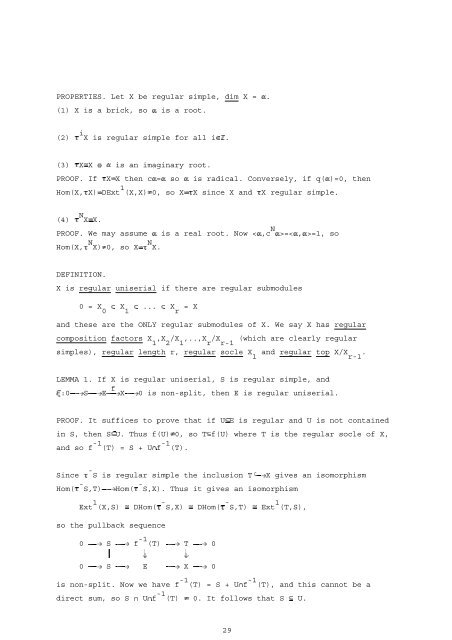Lectures on Representations of Quivers by William Crawley-Boevey ...
Lectures on Representations of Quivers by William Crawley-Boevey ...
Lectures on Representations of Quivers by William Crawley-Boevey ...
Create successful ePaper yourself
Turn your PDF publications into a flip-book with our unique Google optimized e-Paper software.
PROPERTIES. Let X be regular simple, dim X = ¤ .<br />
(1) X is a brick, so ¤ is a root.<br />
i<br />
(2) X is regular simple for all i¡ ¦ .<br />
(3) X X ¢¤ is an imaginary root.<br />
PROOF. If X X then c¤ =¤ so ¤ is radical. C<strong>on</strong>versely, if q(¤ )=0, then<br />
1<br />
Hom(X, X) DExt (X,X)£ 0, so X X since X and X regular simple.<br />
N<br />
(4) X X.<br />
N<br />
PROOF. We may assume ¤ is a real root. Now ==1, so<br />
N N<br />
Hom(X, X)£ 0, so X X.<br />
DEFINITION.<br />
X is regular uniserial if there are regular submodules<br />
0 = X X ... X = X<br />
0 1 r<br />
and these are the ONLY regular submodules <strong>of</strong> X. We say X has regular<br />
compositi<strong>on</strong> factors X ,X /X ,..,X /X (which are clearly regular<br />
1 2 1 r r-1<br />
simples), regular length r, regular socle X and regular top X/X .<br />
1 r-1<br />
LEMMA 1. If X is regular uniserial, S is regular simple, and<br />
f<br />
¢<br />
:0 ¡ S ¡ E ¡ X ¡ 0 is n<strong>on</strong>-split, then E is regular uniserial.<br />
PROOF. It suffices to prove that if U E is regular and U is not c<strong>on</strong>tained<br />
in S, then S U. Thus f(U)£ 0, so T f(U) where T is the regular socle <strong>of</strong> X,<br />
-1 -1<br />
and so f (T) = S + U f (T).<br />
-<br />
Since S is regular simple the inclusi<strong>on</strong> T ¡ ¡ X gives an isomorphism<br />
- -<br />
Hom( S,T) ¡ Hom( S,X). Thus it gives an isomorphism<br />
1 - - 1<br />
Ext (X,S) DHom( S,X) DHom( S,T) Ext (T,S),<br />
so the pullback sequence<br />
-1<br />
0 ¡ S ¡ f (T) ¡ T ¡ 0<br />
¥ ¢ ¢<br />
¦ ¦<br />
0 ¡ S ¡ E ¡ X ¡ 0<br />
-1 -1<br />
is n<strong>on</strong>-split. Now we have f (T) = S + U f (T), and this cannot be a<br />
-1<br />
direct sum, so S U f (T) £ 0. It follows that S U.<br />
29

















